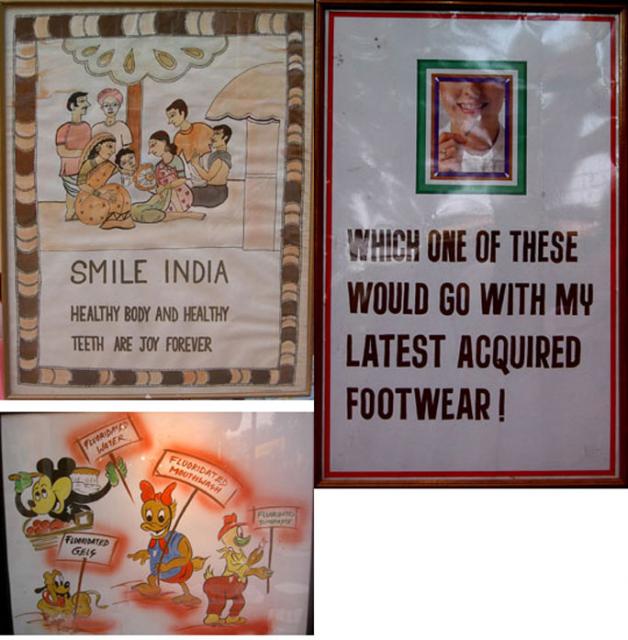
These photos are some of the hundreds of posters that the students had made. The posters were arranged by dental department: the Smile India and the one about shoes are from the Department of Conservative Dentistry (a combination of what would be called Operative Dentistry and Cosmetic Dentistry in the U.S.). Do you like the idea of good teeth as an accessory for good shoes? The fluoride cartoon is from the Department of Periodontics. Actually many parts of India have very high natural levels of fluoride in the water, sometimes 1000 times the beneficial dosage. In some areas they have to worry about fluorosis (tooth and skeletal problems from too much fluoride). So fluoridation of any public water supply is not done, in fact, many localities need to de-fluoridate. These students are good artists and good cartoonists. I mentioned that to General Singh, the Head of the Army Dental Corps, another of the honored guests, and he said, “All dentists must be artists.”
Many of the posters were in Hindi, some in Urdu, some in English. All were well done in that the pictures told the message. There were also other visuals, like a skeleton that had been rigged with a little motor so its arm moved and brought a cigarette to its face. There was one from the Pedodontics Department that was a group of Barbie and Ken dolls to illustrate the relationship triangle that needed to exist between the child patient and the dentist (Ken) and between the patient and the parent (Barbie in a sari) and between the parent and the dentist.
Along with the posters, all week they will be doing free oral health exams for anyone who comes. This has been advertised in the newspaper and has been featured on TV, so they are expecting some 1500 people per day, many of who will not have previously been to a dentist.
And there are also featured speakers on oral health topics. Yesterday's was by Dr. K.K. Agaarwal, a cardiology professor from the Maulana Azad Medical College. What a great speaker! He was making the connection between oral health and general health, both the specific connection between periodontal infections and heart disease, but also a more general Ayurvedic connection. The risk factors for oral disease are the same as those for all major chronic non-communicable diseases (the major message of the World Health Organization: dirt, diet, tobacco and alcohol.) Dr. Agaarwal is an allopathic cardiologist, but as a public health talk to this Indian audience, he phrased it all in Ayurvedic terms, which appeared to be general cultural knowledge. He spoke mostly in English, after starting out by saying to this audience of more than 100 people, “I see at least two foreigners here, who aren't likely to understand if I speak in Hindi. How many of the rest of you only speak Hindi?” It was just one person, so he said he'd go with English, with some Hindi mixed in. [You can tell from what he said that we aren't blending in too well. And its always so embarrassing to only know one language.]
So, his Ayurvedic version of sound nutrition was something like this: The mouth is the entrance to the body and if the entrance is not healthy, the body will not be healthy. So to be healthy you need hygiene, and you need the right foods. Eat a variety of foods, especially foods that are seasonably abundant, so cheap and no preservatives. For example, eat mangoes in the summer, not in the winter, because they are abundant in the summer and they are a “cold” food that you need in the summer. There are seven colors of foods, and each color is a vitamin, so eat all of the colors. There are six tastes and you need a balance of all the tastes. And everything in moderation. Except for tobacco. Tobacco is such a poison that no organism other than the tobacco mosaic virus eats it, so we shouldn't take it in either.
For the final part he apologized to us, but said he had to speak in Hindi because it was from the Hindu scriptures. I know that some of the people at the school and in the audience are Moslem or Christian, but they seemed to understand what he was saying. And the upshot of it all was a description of exactly the foods and exactly the message that the American Heart Association would put out, but phrased very differently. No mention of “good” and “bad” cholesterol, no numbers to show the “correct” blood levels of various molecules. Actually its better than the American Heart Association messages because they leave out the connection between heart health and oral health.


